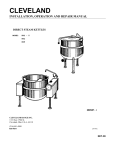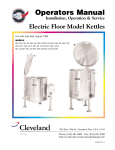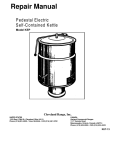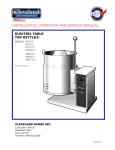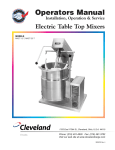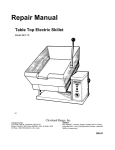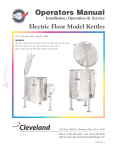Download Cleveland KEL-40-INS Repair manual
Transcript
CLEVELAND INSTALLATION, OPERATION AND REPAIR MANUAL CLEVELAND RANGE INC. 1333 East 179th St. Cleveland. Ohio U.S.A. 44110 (216)481-4900 9209 REV:1 213-01CC KET-06 CLEVELAND INSTALLATION, OPERATION AND MAINTENANCE INSTRUCTIONS FOR ELECTRIC SELF-CONTAINED KETTLES KEL-25 KEL-40 KEL-60 KEL-80 KEL-100 KEL-25-T KEL-40-T KEL-60-T KEL-80-T KEL-100-T FLOOR MODELS SSE-25-L SSE-40-L SSE-60-L SSE-80-L SSE-100-L SSE-25-T SSE-40-T SSE-60-T SSE-80-T SSE-100-T RETAIN THIS MANUAL FOR YOUR REFERENCE INSTALLATION INSTRUCTIONS 4. Fill out all carrier claims forms and have the examining carrier sign and date each form. WARNING: Installation of this kettle must be accompanied by qualified electrical installation personnel working to all applicable local and national codes. Improper installation of this product could cause injury or damage. INSTALLATION The first installation step is to refer to the specification sheet for the clearance requirements, in order to determine the location of the kettle. Next, carefully cut open the shipping carton for easy removal of the kettle. This equipment is built to comply with applicable standards of manufacturers. Included among these approval agencies are UL, NSF,ASME/Ntl. Bd., CSA,ETL,and others. Many local codes exist, and it is the responsibility of the owner and installer to comply with these codes. INSPECTION Before unpacking visually inspect the unit for evidence of damage during shipping. If damage is noticed, do not unpack the unit, follow shipping damage instructions. SHIPPING DAMAGE INSTRUCTIONS If shipping damage to the unit is discovered or suspected, observe the following guidelines in preparing a shipping damage claim. 1. Write down a description of the damage or the reason for suspecting damage as soon as it is discovered. This will help in filling out the claim forms later. 2. As soon as damage is discovered or suspected, notify the carrier that delivered the shipment. 3. Arrange for the carrier's representative to examine the damage. ASSEMBLY Position the kettle in its' permanent location, and level the kettle by turning the adjustable flanged feet. Once positioned and leveled, permanently secure the kettle's flanged feet to the floor using 5/16 inch lag bolts and floor anchors (supplied by the installer). There are three bolts required to secure each of the flanged feet. 1 TILTING MODELS ELECTRIC SERVICE CONNECTION Remove the screw at the rear of the console cover and remove the cover. A wiring diagram is affixed to the underside of the console cover. Feed permanent copper wiring through the cutout in the bottom of the console, and fasten to the three-connection terminal block. Be sure to connect the ground wire to the separate ground terminal connector (ground lug). Repla ce the console cover and secure it with the screw. Install in accordance with local codes and/or the National Electric Code ANSI/NFPA No. 70-1990 (USA) or the Canadian Electric Code CSA Standard C22.1 (Canada). A separate fused disconnect switch must be supplied and installed. The kettle must be electrically grounded by the installer. The electric supply must match the power requirements specified on the kettle's rating plate. The copper wiring must be adequate to carry the required current at the rated voltage. Refer to specification sheet for all electrical specifications. INSTALLATION CHECK Although the kettle has been thoroughly tested before leaving the factory, the installer is responsible for ensuring the proper operation of the kettle once installed. The kettle is wired for 3-phase operation at the factory. For single phase operation, rewire the terminal block to that shown in the accompanying diagram. 1. Supply power to the kettle by placing the fused disconnect switch to the "on" position. 2. Read the vacuum/pressure gauge to ensure that the needle rests in the green zone(at room temperature). If the needle is in the "vent air" zone, refer to the "Kettle Venting Instructions". 3. Place the kettle's power on/off switch to the "on" position. 4. Turn the temperature control knob to "min". The green LED light should remain lit, indicating the heater elements are energized, until the set temperature (124°F/50°C) is reached. Then the green light will cycle on and off with the thermistor (solid state control). ELECTRICAL CONNECTION STATIONARY MODELS Remove the screws securing the dome-shaped service cover underneath the kettle and remove the cover. A wiring diagram is affixed to the inside of cover. Fasten permanent copper wiring to the three-connection terminal block. Be sure to connect ground wire to the separate ground terminal connector (ground lug). Slide the cover's slot over the wiring and secure the cover to kettle with the screws. 2 5. If the kettle is a tilting model, tilt the kettle forward. The red "low water" light should be lit when the kettle is in a tilted position. This light indicates that the heater elements are not submerged in water, and they have automatically been shut off by the kettle's safety circuit. This is a normal conditon when kettle is in a tilted position. 6 Lower the kettle to the upright position. The red "low water" light should go out when the kettle is upright. If the red light remains lit in the upright position, it indicates a low water condition, and water must be added to reservoir before the kettle can be operated. Refer to the "Reservoir Fill Procedures", on the kettle's label, for details. 7. 8. KETTLE VENTING INSTRUCTIONS If the vacuum/pressure gauge reading is in the "vent air" zone, it means that the air has entered the steam/water jacket, resulting in little or no vacuum. Air inside the jacket will act as an insulator therefore reducing kettle efficiency. To remedy this situation, the following venting procedures should be followed: Turn the temperature control knob to "max." and allow the kettle to preheat. The green light should remain on until the set temperature is reached (260°F/127° C), then cycle on and off with the thermistor. Fill the kettle with cold water to the steam jacket's welded seam. Refer to the chart below for the time required to bring the water to a boil. When all testing is complete, empty the kettle and place the power on/off switch in the "off" position. The accompanying chart shows approximate times required for electric kettles of various capacities to boil water. Temperature control knob must be set at "Max." throughout the heatup period. Water will boil about 1/3 faster if the kettle is filled only to the outer steam jacket's welded seam, resulting in a kettle filled to 2/3 capacity. 1. With the temperature control knob set at number 6 or 7, heat the empty kettle until the vacuum/pressure gauge indicates 5-10 psi. 2. Release steam and air from the steam/water jacket by loosening, one-half turn, the 7/16 inch chrome-plated brass venting valve nut (located at the rear of the kettle) for 10-15 seconds. 3. Tighten the vent valve nut, being careful not to overtighten. The kettle's steam/water ja cket should now be free of air. At room temperature, the pressure gauge needle should rest in the green zone, indicating a vacuum in the kettle's jacket. 3 To check the gauge for proper vacuum after venting, the temperature can be quickly reduced by filling the kettle with cold water. On tilting kettles, it is normal for the red light to come on when the kettle is in a tilted position, as the elements are not submerged in water at this point. If the kettle will not hold a vacuum, have a qualified service technician test for leaks at the vent valve, the safety valve, the probe, and the vacuum/pressure gauge fittings. We suggest mixing a 50/50 solution of liquid detergent and water while heating the kettle to at least 5 psi pressure. Then, shut off power to the kettle at the fused disconnect switch. The soapy solution should be applied to the suspected area while the gauge shows at least 5 psi pressure. Any bubbles which appear will indicate a leak. WARNING: The fused disconnect switch must be off before removing the kettle's bottom cover, which exposes dangerous high voltage. 1. Ensure kettle is at room temperature. 2. Shut off power to the kettle at the fused disconnect switch. 3- Remove the bottom cover (tilting kettles can be tilted forward for easier access to the cover). Tilt the kettle back to the upright position once the cover has been removed. 4. Unscrew and remove the chrome-plated brass venting valve nut located on the back of the kettle. 5. Hold the safety valve open while adding distilled water through the vent hole, using a funnel. Refer to chart below for the proper amount required. 6. Place the chrome-plated brass venting valve nut into the water fill bole and carefully tighten. Do not overtighten. Replace bottom cover. 7. Restore power to the kettle at the fused disconnect switch. 8. The kettle must now be vented. Refer to the "Kettle Venting Instructions". RESERVOIR FILL PROCEDURES The reservoir's water level must be maintained at the proper level to submerge the heater elements. Under normal operating conditions, the sealed water reservoir should never require the addition of water. If the red "low water" light comes on during use (while the kettle is in an upright position), the water level has reached a critically low level. The low water protection control has automatically shut off the heater elements. The following procedure must be completed before further use: NOTE: CAUTION: Have a qualified service technician locate and repair the leakage problem before adding water to the unit. Ensure that the red "low water" light is on when the kettle is upright. 4 Only distilled water should be used when adding water to a partially filled water reservoir. Local tap water conditions may cause kettle damage which is not covered under warranty. NOTE: DISTILLED WATER REQUIREMENTS When Red "Low Water Light'' Comes on, Add Distilled Water When the Reservoir is Completely Empty, Add Distilled Water 30gaL 1.80 gal 4.25 gal 40 gal 60 gal 80 gal 100 gal 2.00 gal. 2.10 gal 2.60 gal 2.80 gal 4.50 gal 5.50 gal 6.25 gal 7.00 gal Kettle Capacity 5. Place the food product into the kettle. 6. Turn the temperature control knob to the required temperature setting between "Min." (120° F/49° C) and "Max." (260° F/127° C). The green light will cycle on and off with the solid state control, indicating the heaters are cycling on and off to maintain the set temperature. 7. The red "low water" light should not be lit during kettle operation. This light indicates that the heater elements are not submerged in water, and they have been automatically shut off by the kettle's safely circuit. On tilting kettles, it is normal for the red light to come on when the kettle is in a tilted position. However, the kettle cannot be operated when the red light remains lit while the kettle is in the upright position. This indicates a low water condition, and water must be added to the reservoir. Refer to the "Reservoir Fill Procedures " for details. 8. When cooking is completed, place the power on/off switch to the “off” position. OPERATING INSTRUCTIONS 1. Before turning the kettle on, read the vacuum/pressure gauge. The gauges needle should be in the green zone. If the needle is in the "vent air" zone, refer to the "Kettle Venting Instructions ". Any air that may be present will increase cooking times. Once heated, the kettle's normal maximum operating pressure is approximately 10-12 psi, while cooking a water base product 2. Ensure that the electrical service to the kettle is turned on at the fused disconnect switch. 3. Place the kettle's power on/off switch to the "on" position. 4. Preheat the kettle by turning the temperature control knob to the desired temperature setting (see temperature range chart). The green light will remain lit, indicating the heater elements are energized, until the temperature setting is reached. When the green light goes off, the heaters are off, and preheating is complete. 5 When cooking egg and milk products, the kettle should not be preheated, as products of this nature adhere to hot cooking surfaces, These types of food should be placed in the kettle before heating is begun. 9. Pour the contents of the kettle into an appropriate container by opening the draw-off valve or tilting the kettle forward. Care should be taken to pour slowly enough to avoid splashing off the product. WARNING: Do not use chloride base detergents. NOTE: As with cleaning food soil from any cookware, an important pan of kettle cleaning is to prevent food from drying on. For this reason, cleaning should be completed immediately after cooked foods are removed. Refer to the "Care and Cleaning Instructions" for detailed kettle washing procedures. TEMPERATURE RANGE CHART Temperature Control Setting 1. Prepare a warm water and mild detergent solution in the kettle. 2. Remove food soil inside the kettle using a nylon brush. Do not use a metal bristle brush, as this may permanently damage the kettle's stainless steel surface. 3. Loosen food which is stuck to the kettle by allowing it to soak at a low setting. 4. If the kettle is equipped with a draw-off valve, it should be cleaned as follows: a. Remove the drain screen from the bottom of the kettle. Thoroughly wash and rinse the screen either in a sink or a dishwasher, then replace it into the kettle. b. Disassemble the draw-off valve first by turning the valve knob counter-clockwise, then turning the large hex nut counterclockwise until the valve stem is free of the valve body. c. In a sink, wash and rinse the valve stem, hex nut and knob. Wash and rinse the inside of the valve body using a nylon brush. d. Reassemble the draw-off valve by reversing the procedure for disassemble. The valve's hex nut should be hand tight only. * Approx. Product Temperature °F °C Minimum 120 49 1 2 3 4 5 6 7 8 9 Maximum 130 145 160 170 185 195 210 230 245 260 54 63 71 77 85 91 99 110 118 127 * Certain combinations of ingredients will result in temperature variations. CARE AND CLEANING Your kettle must be cleaned regularly to maintain its fast, efficient cooking performance, and to ensure its continued safe, reliable operation. 6 5. Rinse kettle interior thoroughly, then dram the rinse water. ELECTRIC KETTLE CALIBRATING PROCEDURE 6. Leave the cover off when the kettle is not in use. 1. 7. Using mild soapy water and a damp sponge, wash the exterior of the kettle, rinse, and dry. Avoid soaking the electric control panel. Always turn off equipment power before using water to wash equipment. Insure the unit has a vacuum before you begin calibrating procedures. If unit requires venting refer to "KETTLE VENTING INSTRUCTIONS'' in this manual. 2. Turn kettle on and set temperature dial to maximum (10). 3. Allow the unit to cycle twice. 4. Check temperature of the inner kettle surface with a digital thermometer. 5. Temperature should be 265°F. 6. Using a screw driver adjust temperature by turning the potentiometer on the black box. Turn very little. Turn clockwise to INCREASE, and counter-clockwise to DECREASE temperature. 7. Allow the unit to cycle twice. 8. Check temperature of the inner kettle surface with a digital thermometer. 9. Repeat steps 4 through 8 until unit is calibrated. NOTE: For more difficult cleaning applications one of the following can be used: alcohol, baking soda, vinegar, or a solution of ammonia in water. Avoid the use of chloride cle ansers, which may damage the kettle's stainless steel surface. WARNING: Steel wool should never be used for cleaning the cooking chamber of kettle. Particles of steel wool become embedded in the cooking surface and rust, which may corrode the stainless steel. WARNING: Never hose down the kettle. Water seeps into the underside of the kettle, shorting and burning out the elements. MAINTENANCE This equipment requires very little preventive maintenance other than daily cleaning. Some kettles are equipped with handwheel tilting mechanisms which require periodic preventive maintenance to assure continued trouble -free operation. Inspect the worm screw, tilting gears and bearings occasionally (at least once a year). Lubricate as required using a high temperature grease. Remove bottom cover, heat kettle and test pressure relief valve twice a year. 7 OPERATING CONTROLS AND INDICATORS ITEM NO. DESCRIPTION FUNCTION 16 On-Off Toggle Switch ( Pg. 213-09DR ) Controls electrical power to kettle. 20 Solid State Temperature Control Knob ( Pg. 213-09DR ) This control knob allows the operator to select kettle heat increments from Min. to Max.(see temperature setting chart in the operating instructions section of this manual). 17 Heat Indicator Light (Green) ( Pg. 213-09DR ) When lit, indicates that the kettle heating elements are on. Cycles On-Off with solid state contols. 21 Low Water Indicator Light (Red) ( Pg. 213-09DR ) When lit, indicates that the kettle heating elements have cut out and the unit requires more water. (See Reservoir Fill Procedure). 15 Vacuum/Pressure Gauge ( Pg. 213-09DR ) Indicates steam pressure in PSI inside the steam jacket as well as vacuum in inches of mercury. 5 Pressure Relief Valve ( Pg. 213-09DR ) In the unlikely event that there is an excess steam build-up in the jacket, this valve opens automatically to relieve this pressure. 1 Chrome Plated Brass Vent ( Pg. 213-09DR ) This valve is used to vent the kettle if there is insufficient vacuum as well as for refilling the kettle with water. (See Venting Instructions and Reservoir Fill Procedures). NS Service Cover ( Not Shown ) Located underneath the kettle. Remove this cover for easy access to contactor, kettle control box, etc. 1-7 Daw-Off Valve ( Pg. 600-04TD ) This valve is used to empty the kettle of either food products or wash water. It is supplied as standard equipment on stationary models and is optional on tilting kettles. 11 Hand Wheel ( Pg. 213-10DR ) Turn to tilt kettle for pouring. 16 Power Tilt Control Switch ( Pg. 213-12DR ) This switch allows the operator to tilt the kettle up or down. 8 PARTS LIST - KETTLE BOTTOM ITEM NO. 1. 2. 3. 4. 5. 6. 7. 8. 9. 10. 11. PART NO. F105025 KE50570 F105022 KE50556 KE51723 KE50997 KE51226 KF51225 KE00458 KE50753 KE51322 KE50750 KE50751 12. KE50377 SK50055 13. KE50376 SK50054 14. 15. 16. 17. 18. 19. 20. 21. 22 23. 24. KE50752 KE50429 KE50504 KE50568 SK50062 KE50988 KE50569 KE50567 KE50558 KE00515 KE51005 DESCRIPTION Bleed vent elbow Bleed vent nut Connector Probe, low water Safety valve, 50 PSI, 1/2" Blow down tube Wire connector terminal Edge connector Solid state control box Relay, 12 VDC Contactor, 208/240V, 40 Amp. (Standard kettles) Contactor, 208/240V, 50 Amp. (Special high wattage kettles-6 elements) Contactor, 208/240V, 60 Amp. (Special high wattage kettles-6 elements) Terminal block section (Large, white) Terminal block section (Small, black) Terminal block end section (Large, white) Terminal block end section (Small, black) Transformer Pressure gauge Switch, toggle, SPST L. E. D green Rubber boot Potentiometer Knob, potentiometer L.E.D. red Safety Thermostat (140° C) Thermistor Rotary seal 9 QTY. 1 1 1 1 1 1 10 1 1 1 2 2 2 3 3 1 1 1 1 1 1 1 1 1 1 1 1 1 KETTLE BOTTOM 10 PARTS LIST - CONTROL HOUSING ITEM NO. 1. 2. 5. 4. 5. 6. 7. 8. 9. 10. 11. 12. 13. 14. 15. 16. PART NO. FA11134 KE50325 FA95008 FA30088 KE50752 KE50315 FA95005 KE50375 FA19186 KE00508 FA95007 KE00151 FA95006 KE51711 KE50377 SK50055 17. KE50376 SK50054 18. 19. 20. 21. 22.-24. 22 23. 24. 25. SE00034 FA10623 FA20029 KE51891 SE00036 KE52192 KE52191 KE52193 KE51730 DESCRIPTION Screw, 10-24 x 3/8"SS Console cover Locknut, 3/4-16 Washer, 1 1/2-OD x 13/16"ID x .125"W See note Transformer, 240/16V Worm Tension pin Tilt shaft Set screw, hand wheel Hand wheel Retaining ring Worm gear Woodruff key Bearing, roller, trunnion Terminal block section (Large, white) Terminal block section (Small, black) Terminal block end section (Large, white) Terminal block end section (Small, black) Bearing assy. Boll, 5/16-24 x 1 1/2" Nut, hex, 5/16-24 Washer, 1 1/2"OD x 13/16"ID x .037"W Thrust bearing assy. Washer, thrust bearing Bearing, thrust Spacer, thrust bearing Bearing, tilt shaft Note: Please order Item no. 22.-24. - Part no. SE00036 11 QTY. 2 1 2 1 2 1 1 1 1 1 1 2 1 1 2 3 3 1 1 1 1 1 2 2 4 2 2 1 CONTROL HOUSING 12 PARTS LIST- POWER TILT OPTION ITEM NO. 1. 2. 3. 4. 5, 6. 7. PART NO. KE51012 FA11134 KE50577 KE51224 KE52386 KE50583 KE50582 KE50377 SK50055 8. KE50376 SK50054 9. 10. 11. 12. 13. 14. 15. 16. 17. 18. 19. 20. 21. 22. 23. 24. 25. 26. 27. 28. 29. 30. 3132. 33. 34.-36. 34. 35. 36. 37. 38. 39. FA95008 FA30088 FA95005 KE50581 KE51011 KE51009 KE51010 KE50752 FA95007 FA95006 KE50580 KE51223 KE51007 FA00012 KE00150 KE50315 KE50441 FA11081 KE51711 KE51731 FA10623 FA20229 SE00034 KE51891 SE00036 KE52192 KE52191 KE52193 FA95037 FA95014 KE50579 DESCRIPTION Gear box lid Screw, 10-24 x 3/8" SS Motor Transformer, 208/120V(HG3J) Transformer, 220, 240/120V(HG5J) Buna-N insert Coupling Terminal block section (Large, white) Terminal block section (Small, black) Terminal block end section (Large, white) Terminal block end section (Small, black) Locknut, 3/4-16 Washer, 1 1/2"OD x 13/16"ID x .125"W See note Tension pin Bridge rectifier Contact section Square spacer plate Square actuator Transformer, 240/16V Retaining ring Woodruff key Water resistant boot Bottom cover Micro switch "0" Ring, circuit breaker Worm gear Worm Tilt shaft Screw, 8-32 x 1/2", SS Bearing, roller, trunnion Bearing, tilt shaft Bolt, 5/16-24 x 1 1/2" Nut, hex, 5/16-24 Bearing assembly Washer, 1 1/2"OD x 13/16"ID x .037"W Thrust bearing assembly Washer, thrust bearing Bearing, thrust Spacer, thrust bearing Key, 3/16" x 3/16" x 3/4" Key, 3/16" x 3/16" x 1" Circuit breaker, 1 amp Note: Please order item no. 34.-36. - Part no. SE00036 13 QTY. 1 1 1 1 1 1 2 3 3 1 1 2 1 2 1 1 6 1 1 1 1 1 1 1 2 1 1 1 1 4 2 1 1 1 1 2 2 4 2 2 1 1 1 POWER TILT OPTION 14 PARTS LIST - TRUNNION ASSEMBLY ITEM NO. 1 2 3 4 PART NO. KE00354-D KE00351-D KE00349 KE50666 DESCRIPTION Trunnion bearing casting Trunnion bearing casting Bolt, 5/16-18 x 1/2" Spherical washer 15 QTY. 1 1 1 1 PARTS LIST - 2" TANGENT DRAW-OFF VALVE ITEM NO. PART NO. 1. to 7. KE50972-B 1. FA21008 FA95049 KE527551 2. 3. KE52754 4. KE52753 5. KE52752 6. FA00111 7. KE52751 DESCRIPTION Draw-off assembly Hex nut Wing nut Knob Hex nut Retainer Piston "O" Ring Valve body QTY. 1 1 1 1 1 1 1 1 16 PARTS LIST - FAUCET ITEM NO. 1 2 PART NO. KE50833 KE50828 KE50829 KE51404 KE51736 3 4 5 6 7 FA95022 FA00016 SE50021 SE50020 KE51403 8 SE50022 DESCRIPTION 3/4" Spout for KS-E-LA for KT-20-EA for KT-30-EA, KT-4O-EA, KT-60-EA Spout nut, short(used on spout KE50833) Spout nut, tall (used on spouts KE50828, KE50829 and KE50830) Retaining ring "O"ring Cold water stem assemby Hot water stem assembly Double pantry control valve (c/w item no. 5,6,8) Yoke connection kit 17 QTY. 1 1 1 1 1 1 1 1 1 PARTS LIST - HINGE ASSEMBLY ITEM NO. 1.-9. 1. 2. 3. 4. 5. 6. 7. 8. 9. 10. 11. 12. 13. 14. PART NO. SE00057 SE00058 KE51218 KE50824 KE50823 KE50820 KE50819 FA11507 FA11284 KE50122 KE50121 KE50821 KE50151 KE00095 FA30500 FA11223 DESCRIPTION Hinge assembly (40 gal. and under) Hinge assembly (60 gal. and over) Body, spring assist hinge Hinge bearing Pin (hinge) Insert, brass adjustment End piece Screws, adjustment Bolts, end block Spring (40 gal. and under) Spring (60 gal. and over) Cylinder Knob, ball type Cover handle (specify model) Lid holder Washer, lid holder Bolt, lid holder 18 QTY. 1 1 1 1 1 1 1 2 2 1 1 1 1 1 1 1 1 ALL KETTLES AND SKILLETS HINGE ADJUSTMENT INSTRUCTIONS 1. Insert 3/8" Allen wrench. 2. Turn clockwise to relieve tension on spring. 3. While tension is released remove one of the two slotted screws. 4. To prevent Allen wrench from springing back abruptly while the second slotted screw is removed, insert a pin (approximately 1/8") in the hole where the first slotted screw was removed from. 5. Remove second slotted screw. 6. While holding Allen wrench remove pin. 7. Turn Allen wrench clockwise to tighten or counter-clockwise to loosen tension to produce desired effect. 8. Re-insert pin in one of the two holes. 9. Tighten one slotted screw in the other hole (it may be necessary to turn Allen wrench slightly to align holes.) 10. Remove pin and repeat step number 9 for other slotted screw. 19 ALL ELECTRIC KETTLES SERVICING GUIDE This section contains servicing information intended for use by Authorized Service Personnel. Note 1: If Fault Isolation Procedure is required, be sure to start at step #1. Note 2: On table top kettles the entire control mounting panel may be removed from kettle control housing for easier troubleshooting and pans replacement. A/ Problem: Kettle is not heating at all. (Kettle must be on and temperature control set.) Possible Causes 1. No incoming power. 2. Kettle is tilted. 3. Low water condition. 4. Defective on/off switch. 5. Defective 12 VDC relay. 6. Defective safety thermostat. 7. Defective contactor/s. 8. 9. 10. 11. 12. 13. Defective potentiometer. Defective low water level probe. Defective thermistor. Defective 240/16 VAC transformer. Defective control box. Defective elements. Fault Isolation Procedure Step 1. 2. 3. 4. Test Is there proper incoming voltage at terminal block? Is the red LED illuminated? Is the green LED illuminated? Do both contactors energize? Result Remedy Yes Go to step #2. No Correct external power supply problem. Yes Follow Kettle Filling Procedure. If this does not correct the problem, go to PROBLEM D. No Go to step #3. Yes Go to step #4. No Go to step #7 Yes Check contactor contacts for pitting. Voltage across contactor terminals while in a closed position indicates a poor contact. Replace contactor/s as necessary. Check elements for short at ground or an open circuit. If element/s are defective contact the factory. Elements are not field replaceable. No Go to step #5. 20 5. 6. 7. 8. 9. Measure continuity across safety thermostat. Yes Is it an open circuit? No Is there 120 VAC present across the coils of Yes the contactors? Remove wire from low water level probe and ground it to the body of the kettle. Do the contactors now energize? Is there 16 VAC present at output of 16 VAC transformer? Replace defective 12 VDC relay. Yes Clean or replace defective low water level probe. Replace defective red LED. No Go to step #8. Yes Go to step #9. No Replace defective 240/16 VAC transformer. Measure continuity of ON/OFF switch. Is it Yes operating properly? Unplug control box and measure the Yes resistance across potentiometer. Is it approx. 0 ohms at max. and 50,000 ohms at min. settings? No 11. Go to step #6. Replace defective contactor/s. No No 10. Replace defective safety thermostat. Remove edge connector from control box. Yes While kettle is cold or thermistor is removed and allowed to cook, measure the resistance between edge connectors pins #2 and #7. Is it approx. 100,000 ohms? No 21 Go to step #10. Replace defective ON/OFF switch. Go to step #11. Replace defective potentiometer. Spray contact cleaner on control box terminals and edge connector. Try box again, if the problem still exists, replace defective control box. Replace defective thermistor. B/ Problem: Kettle heats too slowly or not hot enough. (Note: normal max. operating pressure with an empty kettle is 25-30 psi.) Possible Causes 1. Air in kettle jacket-requires venting. 2. Defective safety thermostat. 3. Defective potentiometer. 4. Defective thermistor. 5. Defective contactors. 6. Defective control box. 7. Defective element/s. Fault Isolation Procedure Step Test Result Remedy 1. In a cold state, does the pressure gauge read in the green zone? Yes Go to step #2. No There is air present in the jacket of the kettle. Follow Kettle Venting Procedure. If constant venting is required, there is a leak that should be corrected. Yes Go to step #3. No Check contactor contacts for pitting. Voltage across terminal of contactor while energized signifies a poor contact. Replace contactor/s as necessary. Check elements for short to ground or open circuit If elements are defective, contact the factory. Elements are not field replaceable. Yes Replace defective safety thermostat. No Go to step #4. Yes Go to step #5. No Replace defective potentiometer. 2. 3. 4. 5. Do the contactors shut off too early? (before reaching normal max. operating pressure). Does the green LED remain illuminated after the contactors shut off? Unplug control box and measure the resistance across potentiometer. Is it approx. 0 ohms at max. and 50,000 ohms at min. setting? Remove kettle thermistor and allow to cool. Yes Remove edge connector from control box. Test resistance across edge connectors pins #2 and #1. Is it approx. 100,000 ohms? No 22 Go to step #6. Replace defective thermistor. 6. Turn the potentiometer on the control box clockwise to increase the max. operating temperature. Does the kettle now achieve max. operating pressure of 25-30 psi in an empty kettle? Yes Kettle is operating properly. No Spray contact cleaner on control terminals and edge connector. Try box again. If problem still exists, replace defective control box. C/Problem: Kettle is overheating. Possible Causes 1. 2. 3. 4. Defective thermistor. Defective potentiometer. Defective 12 VDC relay. Defective control box. Fault Isolation Procedure Step Test 1. 2. 3. 4. Result Does the green LED turn off even though the Yes contractors remain energized? Unplug the control box and measure the resistance across the potentiometer, Is the resistance approx. 0 ohms at max. and 50,000 ohms at min. settings? Remedy Replace defective 12 VDC relay. No Yes Go to step #2. Go to step #3. No Replace defective thermistor. Remove kettle thermistor an allow to cool. Yes Remove edge connector from control box. Test resistance across edge connectors pins #2 and #7. Is it approx. 100,000 ohms?. No Go to step #4. Turn the potentiometer on the control box counter-clockwise to decrease the max. operating temperature. Does the kettle continue to overheat? Yes Spray contact cleaner on control box terminal and edge connector. Try box again. If problem still exists, replace defective control box. No Kettle is operating properly. 23 Replace defective thermistor. D/Problem: Red LED remains illuminated even though water has been added. Possible Causes 1. 2. Defective low water level probe. Defective control box. Fault Isolation Procedure Step Test Result Reme dy 1. Yes Replace or clean defective low water level probe. No Spray contact cleaner on control box terminals and edge connector. Try box again. If problem still exist, replace defective control box. Remove wire from low water level probe and ground the wire to the body of the kettle. Does the red LED turn off? MODEL KS20/KT20 ELECTRICAL RATINGS 208 VOLTS 1 Phase KW 240 VOLTS 1 Phase 3 Phase AMP KW AMP KW AMP KW 3 Phase AMP KW 220/380 VOLTS 1 Phase AMP 3 Phase KW AMP 9.8 47 9.8 27 13 55 13 32 — — 11 25 KS30/KT30 12.3 59 12.3 34 16.4 68 16.4 39 — — 13.6 21 KS40/KT40 14.8 71 14.8 41 19.6 82 19.6 47 — — 16.4 25 KS60/KT60 14.8 71 14.8 41 19.6 82 19.6 47 — — 25 240/416 VOLTS KS20/KT20 KW 1 Phase AMP KW 480 VOLTS 16.4 575 VOLTS 3 Phase AMP 1 Phase KW AMP 3 Phase KW AMP 1 Phase KW 3 Phase AMP KW AMP — — 13 18 9.8 21 9.8 12 18 31 18 18 KS30/KT30 — — 16.4 23 9.8 21 9.8 12 18 31 18 18 KS40/KT40 — — 19.6 27 B.I 27 13.1 16 18 31 18 18 KS60/KT60 — — 19.6 27 19.6 41 19.6 24 24 42 24 24 For electrical supply other than shown above, refer to the wiring diagram affixed to the underside of the console cover. NOTE: Amperage (amps/ph) column above is the actual current draw of the unit. Please reference electrical codes in your area for the correct wire and circuit breaker sizing. 24 STANDARD NORTH AMERICAN WIRING DIAGRAM For electrical supply other than shown above, refer to the wiring diagram affixed to the underside of the console cover. NOTE: Please reference electrical codes in your area for the correct wire and circuit breaker sizing. 25 STANDARD EUROPEAN WIRING DIAGRAM For electrical supply other than shown above, refer to the wiring diagram affixed to the underside of the console cover. NOTE: Please reference electrical codes in your area for the correct wire and circuit breaker sizing. 26 HARRISONS & CROSFIELD (CANADA) LTD. MATERIAL SAFETY DATA SHEET PRODUCT: ETHYLENE GLYCOL SUPPLIER: DATE: 24 October 1986 Harrisons & Crosfield (Canada) Ltd. 777 Supertest Road, Downsview, Ontario, M3J 2M5 Phone (416) 736 9299, Telex 06-524509 Emergency Phone (416) 667 8074 I. IDENTIFICATION SYNONYMS: Glycol; EG; MEG; 1, 2 ethanediol CHEMICAL NAME: Ethylene glycol CHEMICAL FAMILY: Glycols CHEMICAL FORMULA: HOC2H4CH SHIPPING NAME: CLASSIFICATION: Not regulated C.A.S. NUMBER: 107-21-1 P.I.N.: PACKING GROUP: II. HAZARDOUS INGREDIENTS Ingredient Ethylene glycol Range % TLV (ppm) 100 Vapor-50 ppm III. HEALTH HAZARDS THRESHOLD LIMIT VALUE: Vapour - 50 ppm. Paniculate - 10 mg/m3 EFFECTS OF OVEREXPOSURE: EYES: Liquid, vapours, and particularly mists, may cause discomfort in the eye with transient conjunctivitis. Serious corneal injury is not anticipated. SKIN: slightly irritating. INHALATION: May cause irritation of the throat and headache. High vapour concentrations caused, for example, by heating the material in an enclosed and poorly ventilated workspace may produce nausea, headache, and dizziness. INGESTION: May cause abdominal discomfort and pain (dizziness, malaise, lumbar pain, oliguria, uraemia, and central nervous system depression. Severe kidney damage follows the swallowing of large volumes of ethylene glycol. May be fatal. CHRONIC HEALTH HAZARDS: Inhalation of mists may produce signs of effects on the central nervous system, particularly dizziness and nystagmus. OTHER HEALTH HAZARDS: Ethylene glycol has been shown to produce dose-related teratogenic effects in rats and mice when given by gavage or drinking water at high concentrations. There is no available information to suggest that it has caused birth defects in humans. Two chronic feeding studies, using rats and mice have not produced any evidence that ethylene glycols causes dose-related increases in tumour incidence, or a different pattern of tumours compared with untreated controls. The absence of a carcinogenic potential for ethylene glycol has been supported by numerous in vitro genotoxicity studies showing it does not produce mutagenic or clastogenic effects. PRODUCT: ETEYLENE GLYCOL DATE: 24 October 1986 FIRST AID: EYES: Flush with water for at least 15 minutes. SKIN: Remove contaminated clothing and flush skin with water. INHALATION: Remove to fresh air. Call a physician if discomfort persists. INGESTION: If conscious, give two glasses of water and induce vomiting. Call a physician. NOTES TO PHYSICIAN: The principle toxic effect of the material, when swallowed, will be due to the ethylene glycol content, which caused kidney damage. Early administration of ethanol may block the formation of nephrotic metabolites in the liver. Ethanol should be given intravenously, as a 5% solution in sodium bicarbonate, at a rate of about 10 ml. of ethanol per hour. A desired therapeutic level of ethanol in blood is 100 mg/dL. Hemodialysis may be required. See also Section IX. IV. FIRE & EXPLOSION HAZARDS FLASH POINT & method (C): 116 (TCC) FLAMMABLE LIMITS (% in air): LOWER: 3.2 UPPER: 15.3 (est) EXTINGUISHING MEDIA: Use water spray, carbon dioxide, dry chemical, alcohol-type or universaltype foams applied by the manufacturers' recommended technique. SPECIAL FIRE FIGHTING PROCEDURES: Do not spray pool fires directly. A solid stream of water directed into hot, burning liquid can cause frothing. Use self-contained breathing apparatus and protective clothing. UNUSUAL FIRE & EXPLOSION HAZARDS: None currently known V. PHYSICAL DATA The following physical data are approximate only and do not represent specification values. They should only be used in the context of this Material Safety Data Sheet. BOILING POINT (C): 197 SPECIFIC GRAVITY (20C): 1.12 VAPOUR PRESSURE: 0.08 VAPOUR DENSITY (air=l) : 2.1 WATER SOLUBILITY: Complete VOLATILITY (%): Nil EVAPORATION RATE:(Butyl acetate=1): < 0.01 APPEARANCE & ODOUR: Colourless liquid, mild odour. VI. REACTIVITY STABILITY: Stable. CONDITIONS TO AVOID: None currently known. INCOMPATIBILITY: Strong oxidizing agents. HAZARDOUS DECOMPOSITION PRODUCTS: Carbon dioxide and/or carbon monoxide produced on burning. HAZARDOUS POLYMERIZATION: No. CONDITIONS TO AVOID: None currently known. PRODUCT: ETEYLENE GLYCOL DATE: 24 October 1986 VII. SPILLS & LEAK PROCEDURES STEPS TO BE TAKEN IF MATERIAL IS RELEASED OR SPILLED: Wear suitable protective equipment. Small spills - flush with large quantities of water. Large spills - collect for disposal. WASTE DISPOSAL METHODS: Incinerate in a furnace where permitted by Federal, Provincial, and local laws and regulations. VIII. SPECIAL PROTECTION INFORMATION RESPIRATORY PROTECTION: NIOSH or MSHA approved air supplied mask in high concentrations. VENTILATION: General mechanical room ventilation is expected to be adequate if handled in covered equipment. Local exhaust ventilation is needed at points where vapour is expected to be vented to the air. PROTECTIVE GLOVES: Rubber or plastic. EYE PROTECTION: Monogoggles or face shield. ADDITIONAL PROTECTIVE EQUIPMENT: Eye bath and safety shower. IX. ADDITIONAL INFORMATION HANDLING & STORAGE: May be fatal if swallowed. Do not breathe mist. Avoid prolonged or repeated breathing of vapour. Avoid contact with eyes. Wash thoroughly after handling. Where heavy concentrations of fine mist are present, a respirator should be used to prevent inhaling mist particles. OTHER INFORMATION: Pulmonary oedema with hypoxemia has been described in a number of patients following poisoning with ethylene glycol. The mechanism of production has not been elucidated, but it appears to be noncardiogenic in origin in several cases. Respiratory support with mechanical ventilation and positive end-expiratory pressure may be required. ***** END OF REPORT ***** PREPARED BY: Regulatory Services DATE ISSUED: 28 July 1986 Harrisons & Crosfield (Canada) Ltd. DATE REVISED:24 Oct. 1986 The information provided in this Material Safety Data Sheet has been obtained from sources believed to be reliable. Harrisons & Crosfield (Canada) Ltd. provides no warrants express or implied and assumes no responsibility for the accuracy or the completeness of the data contained herein. FINNAN ENGINEERED PRODUCTS LIMITED POISON CONTROL CENTER Toronto: l-800-268-9017 EMERGENCY Tel. No. (416) 438-6070 (416) 294-5237 (416) 497-5512 Quebec MATERIAL SAFETY DATA SHEET City: 418-656-8090 April 28/89 SECTION I PRODUCT INFORMATION NAME OF PRODUCT FINNAN 1524L and 1529L PURPOSE OF PRODUCT Closed System Corrosion Inhibitor CHEMICAL NAME Mixture FORMULA SECTION II COMPONENTS WT/ WT % HAZARDOUS INGREDIENTS Oral-rat LD50 HAZARD CAS NO. Sodium Nitrite 20-24 120mg/Kg Assists combustion 7632-00-0 Tolytriazole 0.2-0.3 675mg/Kg Toxic 29385-43-1 Sodium Hydroxide 0.8 N/Av. Corrosive 1310-73-2 Sodium Tetraborate 3.3 2660mg/Kg LDL0, man, 709 mg/Kg 1330-43-4 SECTION III APPEARANCE AND PHYSICAL STATE Straw color liquid PHYSICAL STATE ODOUR Mild 1. BOILING POINT ° C (°F) >100°C 5. pH OF PRODUCT OR ACID/BASE CONTENT 11.5-12.0 2. VAPOUR PRESSURE DENSITY (Air=1) 3. SOLUBILITY IN WATER N/Ave. 6. SPECIFIC GRAVITY (Water=1) 1.20-1. 22 Miscible 7. FREEZING POINT N/Av. 4. PERCENT VOLATILE 71% as water 8. AUTODECOMPOSITION TEMP. 490°C SECTION IV FIRE AND EXPLOSION HAZARD DATA FLAMMABLE LIMITS : Upper Lower EXTINGUISHING MEDIA As appropriate for combustibles in area. FLASH POINT N/Ap. SPECIAL FIRE FIGHTING PROCEDURES Self-contained breathing apparatus and protective clothing must be worn in fighting all fires involving chemicals. SECTION V HEALTH HAZARD DATA A - EFFECTS OF ACUTE OVEREXPOSURE (A) SKIN Corrosive to skin, may cause dermatitis. (B) INHALATION For nitrite , 4 hr. LC50 in rats: 1.45 mg/litre of air. (C) INGESTION Harmful or fatal if swallowed. (D) EYES Corrosive to eyes. B - EFFECTS OF CHRONIC OVEREXPOSURE - Nitrite not listed as a carcinogen by ACGIH, IARC or OSH. - Nitrite tests on animals demonstrate no embryotoxic or reproductive toxicity. - See Appendix. SECTION VI EMERGENCY AND FIRST AID (A) SKIN Wash with soap and water at once while removing contaminated clothing (B) INHALATION No exposure is expected at room temperature. (C) INGESTION If victim is conscious, induce vomiting by giving two glasses of water or salt water and inserting finger down throat. Call Poison Control or a physician immediately. (D) EYES Immediately flush eyes with copious amounts of water for 20 mins. Consult a physician if redness or irritation persists. SECTION VII TOXICOLOGICAL DATA EXPOSURE LIMITS: Not established. ROUTE OF ENTRY: Skin or eye contact, ingestion. SECTION VIII SPILL OR LEAK PROCEDURES STEPS TO BE TAKEN IN CASE MATERIAL IS RELEASED OR SPILLED Collect and reuse as much as possible, absorb the residues with sand or other mineral absorbent materials and dispose of. DISPOSAL PROCEDURES Follow your local, provincial and federal chemical disposal regulations. SECTION IX PROTECTION INFORMATION RESPIRATORY PROTECTION: LOCAL EXHAUST GLOVES MECHANICAL EXHAUST APRONS SAFETY CHEMICAL GOGGLES GLASSES OTHER PROTECTIVE EQUIPMENT: Eyewash station. FACE SHIELD SECTION X REACTIVITY DATA STABILITY STABLE UNSTABLE HAZARDOUS DECOMPOSITION OR COMBUSTION PRODUCTS Toxic brown nitrogen dioxide gas is formed. CONDITIONS TO AVOID Mixing with acids or strong oxidizing chemicals must be avoided. SECTION XI HANDLING AND STORAGE PRECAUTIONS Handle as an alkaline liquid. Store away from acids and oxidizing chemicals. Keep the lid closed at all times. SECTION XII FURTHER INFORMATION Under certain circumstances, when dry nitrite comes in contact with combustible material, it may act as a source of oxygen, thus assisting combustion. Do not add amines to water systems containing Finnan 1524L or Finnan 1529L to avoid formation of carcinogenic nitrosamines.


































